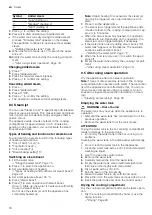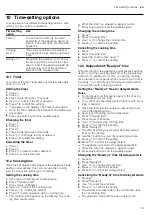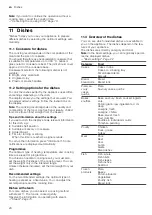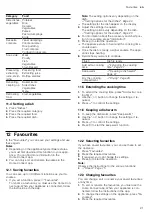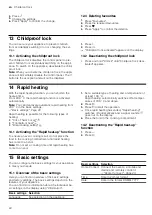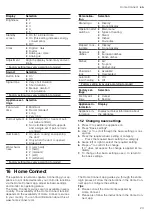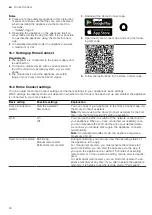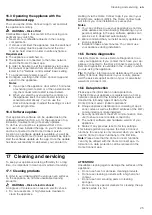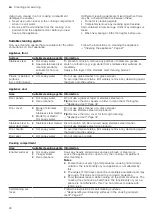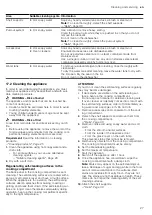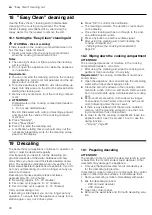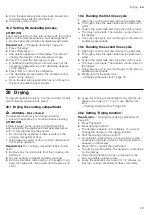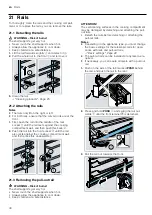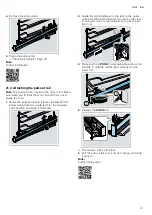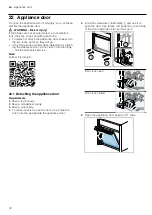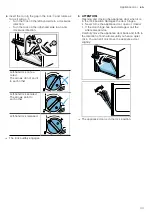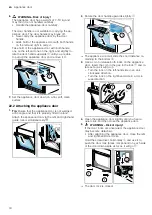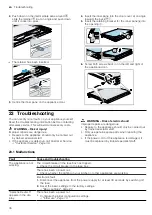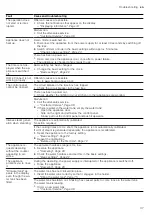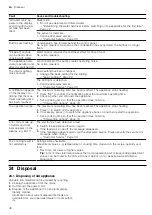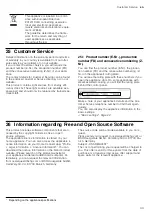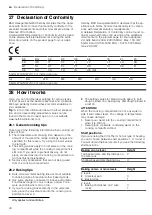
Cleaning and servicing
en
27
Area
Suitable cleaning agents Information
Shelf supports
¡
Hot soapy water
Soak any heavily soiled areas and use a brush or steel wool.
Note:
To clean thoroughly, detach the shelf supports.
Pull-out system
¡
Hot soapy water
Use a brush to remove heavy soiling.
Clean the pull-out rails while they are pushed in so that you do not
remove the lubricant.
Do not clean in the dishwasher.
Note:
To clean thoroughly, detach the pull-out system.
Accessories
¡
Hot soapy water
¡
Oven cleaners
Soak any heavily soiled areas and use a brush or steel wool.
Enamelled accessories are dishwasher-safe.
Do not use stainless steel wool on steam containers made from
stainless steel.
Use a vinegar solution to remove any dirt on stainless steel steam
containers caused by starchy foods (e.g. rice).
Water tank
¡
Hot soapy water
To remove residual detergent after cleaning, rinse thoroughly with
clean water.
To dry the water tank after cleaning, leave the water tank to dry with
the lid open. Dry the seal on the lid.
Do not clean in the dishwasher.
17.2 Cleaning the appliance
In order to avoid damaging the appliance, you must
clean your appliance only as specified, and with suit-
able cleaning products.
WARNING ‒ Risk of burns!
The appliance and its parts that can be touched be-
come hot during use.
▶
Caution should be exercised here in order to avoid
touching heating elements.
▶
Young children under 8 years of age must be kept
away from the appliance.
WARNING ‒ Risk of fire!
Loose food remnants, fat and meat juices may catch
fire.
▶
Before using the appliance, remove the worst of the
food residues and remnants from the cooking com-
partment, heating elements and accessories.
Requirement:
Read the information on cleaning
products.
1.
Clean the appliance using hot soapy water and a
dish cloth.
‒
For some surfaces, you can use alternative
cleaning agents.
"Suitable cleaning agents", Page 26
2.
Dry with a soft cloth.
Regenerating self-cleaning surfaces in the
cooking compartment
The back panel in the cooking compartment is self-
cleaning. The self-cleaning surfaces are coated with a
porous, matt ceramic layer and have a rough surface.
When the appliance is in operation, the self-cleaning
surfaces absorb splashes from baking, roasting or
grilling, and break them down. If the self-cleaning sur-
faces no longer clean themselves adequately during
operation, heat up the cooking compartment specific-
ally to the right temperature.
ATTENTION!
If you do not clean the self-cleaning surfaces regularly,
they may become damaged.
▶
If dark stains are visible on the self-cleaning sur-
faces, heat up the cooking compartment.
▶
Do not use oven cleaner or abrasive cleaning aids.
If oven cleaner accidentally comes into contact with
the self-cleaning surfaces, dab it off immediately us-
ing water and a sponge cloth. Do not rub.
1.
Remove accessories and cookware from the cook-
ing compartment.
2.
Detach the shelf supports and remove them from
the cooking compartment.
3.
Remove coarse dirt using soapy water and a soft
cloth:
– From the smooth enamel surfaces
– From the inside of the appliance door
– From the glass cover on the oven lamp
This prevents stains that cannot be removed.
4.
Remove any objects from the cooking compartment.
The cooking compartment must be empty.
5.
Set the bread-baking setting.
6.
Set the maximum temperature.
7.
Start the operation.
8.
Switch off the appliance after 1 hour.
9.
Once the appliance has cooled down, wipe the
cooking compartment with a damp cloth.
Note:
Marks may appear on the self-cleaning sur-
faces. Residues of sugar and egg white in the food
are not removed and stick to the surfaces. Red
stains are residues from salty food – they are not
rust. The stains are not hazardous to health. These
marks do not impair the cleaning ability of the self-
cleaning surfaces.
10.
Attach the shelf supports.
Summary of Contents for B59FS3A 0 Series
Page 1: ...Combi steam oven User manual and installation instructions B59FS3A 0...
Page 58: ......
Page 59: ......






